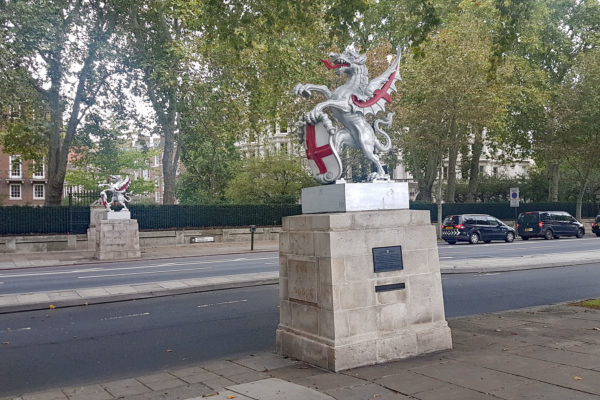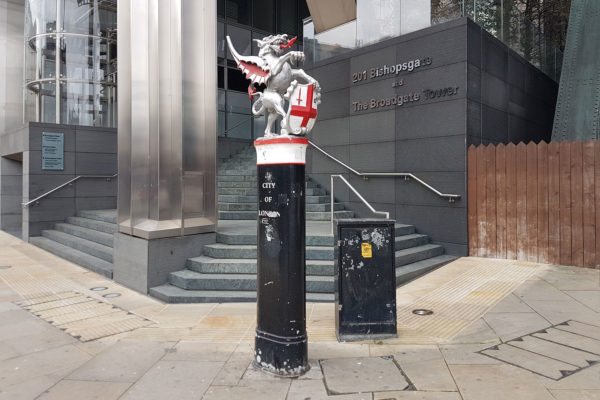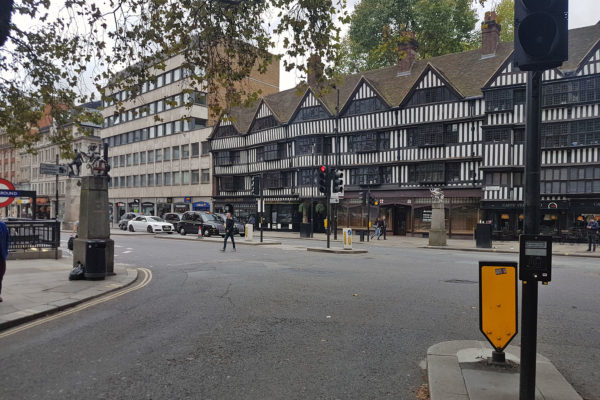The ancient City of London is protected by dragons that guard the main roads into the city from perfidious invaders. They look ancient, yet the dragons around London are fairly new, albeit based on something that can trace its origins back to the Great Fire of London.
These are the Dragon Boundary Marks, the City of London’s own variant of the road signs you see as you approach small towns such as Dunny-on-the-Wold, usually with a note underneath to drive carefully. Being the City though, no mere utilitarian signs, but DRAGONS!
There are two designs for the dragons — one example can be found on Fleet Street, and while it looks grander and older, the design that’s come to dominate is, in fact, an older one.
The common design is based on two huge dragons that once stood above the entrance to the Coal Exchange. The trade in coal in London was hugely important, not just because it fueled the city, but thanks to taxes that were introduced after the Great Fire of London, it’s funded a lot of London building works.
Much like the City boundary dragons, there are also Coal Posts that encircle the old boundary for the coal tax, and many examples still exist dotted around Greater London. To help manage the trade in coal, in 1847 a grand building was constructed near the Tower of London, and high above the main entrance, two plinths held two large cast-iron dragons.
The dragons designed by the City Architect, J. B. Bunning, and made by London foundry, Dewer, in 1849.
The building no longer exists sadly, having been torn down in 1962 despite howls of protest to save it — and a very bland office block erected on the site. While the Victorian building was demolished, the Roman remains in the basement were fortunately saved, and are now open for tours.
The other thing saved though were the two dragons, and the following year they were moved to Embankment and erected as boundary marks for the City. The date was a convenience, as the government was redrawing local government boundaries in 1963, so the City decided to mark its boundaries in physical form.
Over the next few years a number of half-size replica dragons were erected around the City, and they’re still there in varying states of repair.
The dragons are all painted silver, with details of their wings and tongue picked out in red. The dragon stands on one rear leg, the other lifted against a shield, with the right foreleg raised and the left foreleg holding a shield which bears the City of London’s coat of arms, painted in red and white. The stance is the equivalent of the rampant heraldic attitude of the supporters of the City’s arms.
There is an odd rumour that they are griffins, but they are officially Dragon Supporters — in that they are a) dragons, and b) supporting the shield. The sword in the crest is the badge of the Patron Saint of the City of London, St Paul.
Let’s walk around the city taking a look.
Embankment
Let’s start with the originals — two massive iron statues that are now painted, and stand on either side of Embankment to announce This Is The City.
A bronze plaque stating that “These dragons represent a constituent part of the armorial bearings of the City of London and have been erected to indicate the western boundary of the city. This commemorative plaque was unveiled by the Rt Hon The Lord Mayor Sir Ralph Edgar Perring on 16th October 1963”
A smaller sign below adds that the dragons were formerly mounted above the entrance of the City of London coal exchange which was demolished in 1963.
If you look on the back of the shield, it says Dewer London 1849, confirming the earlier information about the Coal Exchange building. They are looking rather good at the moment, having been recently restored.
Less noticed though is a stone plaque on the wall next to the dragon. This marks the last visit by Queen Victoria to the City of London in March 1900 and the location where she was presented with the Mayor’s sword.
Blackfriars
One of the many quirks of the City is that the bridges across the Thames within the City boundaries are managed by an ancient trust fund at no cost to the taxpayer.
Although all the bridges are therefore nominally owned by the City, the local authority boundaries generally run down the middle of the river – except for Blackfriars and London Bridge, where the south bank of the river is still inside the City of London.
Here on Blackfriars then is one solitary dragon standing right in the middle of the busy road, and hence rather difficult to get up close to and take photos of.
London Bridge
Another pair of dragons, on either side of the bridge.
Both are mounted on stone plinths, although the eastern one is also raised up on a wide platform, which is now more often used as seating by people needing a break. The eastern side is also by far the busiest.
Tower Hill
Here, on the boundary next to the Tower of London can be found the next boundary marker. It often surprises people to learn that the Tower is not part of the old City of London, but was it’s own liberty and thanks to old militia regulations, was later incorporated into Tower Hamlets council.
This dragon does mark one important point, where the clergy of the church behind, All Hallows mark their parish boundary with the Tower, and every three years, hold a joint ceremony in memory of a time when parish boundaries were fought over.
Aldgate
This is a Dragon that moves. The area has seen a lot of roadworks over the past decade, and the dragon used to stand a bit further to the east in a pedestrian traffic island. That is now the middle of a road, so in 2014 the dragon was removed, and a couple of years ago the dragon was erected at its current location outside Aldgate House.
The stone wall behind the dragon is a ventilation shaft for the London Underground that runs directly underneath.
Liverpool Street
This dragon is in its original location, although recently restored as the building it stands outside of is new and it was covered in hoardings for many years.
Barbican
This is the sorriest looking of the City Dragons and in dire need of a bit of tender loving care.
It’s decayed surprisingly quickly as it looked freshly painted in 2008, so either the paint was bad, or it’s suffered from its location.
Based at the edge of the city after it expanded to include its first road, the dragon sits by a row of flats above shops that have the curious attempt to look Tudor – while being made from concrete.
One of our Dragons is missing
There used to be a dragon on Moorgate, at the junction with South Place, but it was removed some years ago – temporarily — due to Crossrail construction works going on just down the same road. Occasionally very large loads need to come down the road, and not even one of London’s dragons could hold back a modern lorry.
Farringdon
Standing outside the derelict old market buildings that are soon to be converted into the new Museum of London, this dragon has recently been repainted.
It was looking quite poorly when removed in late 2017 so that the pavements in the area could be revamped, and when returned to its home, here at the edge of Farringdon, it had been polished and painted as if new.
Chancery Lane
Another twin set of dragons that stand on either side of the road. Also the first of the tour to be mounted on an older stone rather than a metal pedestal.
The stone column is incised with the crest of the City of London, and brass inlaid text for the City.
The plinths are interesting as they are obviously different from the other dragon’s which are mounted on thin metal columns or the two on Embankment which had dedicated stone plinths made for them. It seems that the plinths already marked the boundary with the City and predate the dragons. They were simply reused. If you look very closely at this photo, you can see the plinth behind the tube station entrance, with the original pyramid topping.
Temple Bar
We end the tour with the dragon that got rejected.
The location is the old Temple Bar, a huge stone archway that used to collect tolls when people had to pay to use roads, but roads became free, and the building was a hindrance, so it was removed, and after moving around a bit the building is now next to St Paul’s Cathedral.
However, in 1880, a memorial to the Temple Bar was erected on the site — slightly undoing the aim of improving road traffic, and is decorated on each side with statues of Queen Victoria and the Prince of Wales. A relief at the base is worth taking a closer look at, if you can dodge the road traffic.
At the top though, is the item we’re interested in, a rather fierce-looking dragon designed by Charles Bell Birch. When the City of London was considering the design for its boundary marks, this dragon was considered, but they went with the Coal Exchange dragons instead, and I for one think that was a wise decision.
The Temple Bar dragon looks a bit too — for what of a better phrase — lifelike, whereas the Coal Exchange dragons look suitably heraldic and that’s a much better design for the boundary markers.
Two of our Dragons are in the USA
Next to the famous London Bridge in Lake Havasu in Arizona is a tacky looking tourist shopping centre, and inside there, two replicas of the City of London boundary dragons, on copies of the pedestals they have in London.
The only difference is that the pedestal is not painted black, and the shields aren’t white, otherwise, they’re a perfect copy.
I haven’t included them on the map above.






























When I first went to work in the City in the 1970s my walk across London Bridge in the morning was often enlivened by the sight of the bridge dragon gripping an empty beer can in his claws. I wonder if that still happens.
Great piece, Ian, thank you.
Excellent overview and history. Thank you.
May I however point out that the ‘flats above shops’ attempting to look Tudor on Goswell Road are in fact the Grade II* listed Crescent House, part of the Golden Lane Estate?
In fact that bit of City became part of the Square Mile only with the construction of that estate, unwittingly giving the Corporation its first ‘road’ – Goswell Road.
I still think the Grade II* listed Crescent House is flats above shops attempting to look Tudor.
Not quite so re timing – Crescent House was built in 1962 by the City, but was entirely within the Metropolitan Borough of Finsbury. In 1965 following the reorganisation and amalgamation of London local authorities it fell within the London Borough of Islington. Only on 1st April 1994 did legislation come into effect that moved the City/Islington boundary to its current position
Very interesting subject. I remember them from the days I worked in the city. Nice to know that many are still in situ and maintained.
Plus the one where Byward St changes to Tower Hill
https://goo.gl/maps/X4tDZVRtDpKHgtst9
Cheers, that’s been added.
Superb!
I do hope the Moorgate Dragon makes a re-appearance
The Temple Bar dragon is also on a ley line. If you believe in that sort of thing.